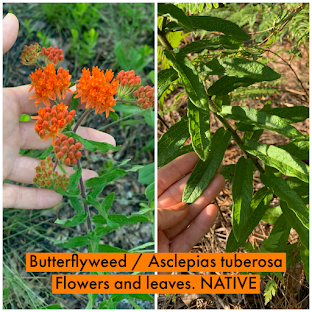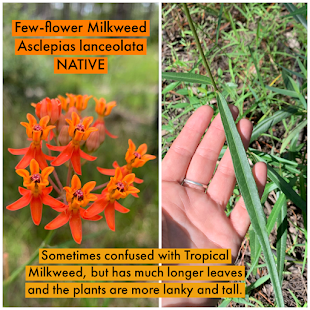Tropical Milkweed is Harmful to Monarchs & Florida Ecosystems
By Lilly Anderson-Messec
The red and yellow blooms of tropical milkweed, Asclepias curassavica, are ubiquitous in Florida butterfly gardens. This non-native milkweed has exploded in popularity as demand for milkweed grows to support declining monarch butterfly populations. This tropical species is native to Mexico and very easy to propagate, so growers are able to quickly produce plant material to meet the milkweed demand. It’s also very showy, blooming prolifically all season and regrowing quickly after being decimated by hungry caterpillars.
Unfortunately, tropical milkweed has been an increasingly invasive species in Central and South Florida for many years, and has begun spreading in North Florida as well. It’s fast growth and prolific re-seeding have resulted in large monocultures of tropical milkweed in natural areas. This unchecked growth replaces native plants and disrupts the native ecosystems that both wildlife and humans rely on. The invasive quality of this plant is is just one of the reasons we recommend removing tropical milkweed in your yard. Unlike our native milkweed species which naturally senesce in the fall, the lush green foliage of tropical milkweed will stay up all winter if not killed back by frost, which has become a problem for the already imperiled monarch.
A protozoan parasite that evolved with monarch butterflies, Ophryocystis elektroscirrha (OE) lives on infected monarchs and is deposited on the plants they land on; especially when the butterflies lay eggs on the plants. The resulting caterpillars hatch and ingest the OE as they eat the plant, and the parasite is able to replicate inside them. Those caterpillars will grow into butterflies infected with an increased load of OE that they will shed on other milkweed plants they land on, continuing the cycle.
Many species across the animal kingdom have evolved with their own particular parasites – humans included. These parasites are often not too harmful to their host since their own survival is dependent upon the survival of their host. However, if the delicate balance between host and parasite is suddenly effected by a change in their environment, one of the pair may be given an advantage. If the parasite is allowed to accumulate too much, it can kill their host. Monarchs evolved with OE and are naturally able to prosper while still carrying a small amount of the parasite, but high OE levels in adult monarchs can cause them to fail to emerge from their pupal stage because they are too weak and unable to fully expand their wings. Monarchs with slightly high OE loads can appear normal, though they are usually somewhat smaller in size. Despite this survival, they don’t live as long, cannot fly as well, and are therefore unable to migrate successfully.
Our native milkweeds naturally senesce in the fall and stay leafless and dormant through the winter, which effectively cleans the plant of the seasonal OE parasite load. When the leaves die back, the parasite dies along with them so that when butterflies return each spring and summer, they feed on fresh, parasite-free foliage. In contrast, tropical milkweed remains evergreen throughout the winter, allowing OE levels to accumulate on the plant. The following generations of monarch caterpillars that feed on those plants are exposed to dangerous levels of OE.
As our winters have become increasingly warmer in North Florida, the invasive potential of tropical milkweed is growing. Warmer winters also mean tropical milkweed is less likely to be killed by frost and more likely to accumulate excessive OE on its leaves. Tropical milkweed can also interfere with monarch migration and reproduction. In northern areas it grows later into the season than native species do, and some studies have shown that just the presence of tropical milkweed may confuse monarchs into breeding at a time when they should be migrating. There is evidence that suggests the chemical composition of tropical milkweed may trigger this disruption of the innate migration cycle of the monarchs that interact with it. This creates a trap for monarchs, as they are fooled into thinking that they have arrived in the safe wintering grounds of Mexico, when they are not - and the inevitable winter freeze kills them.
With the mounting evidence of the detrimental effects of tropical milkweed, many organizations involved in monarch conservation, such as the Xerces Society and Monarch Joint Venture have begun recommending against planting non-native milkweed - even going so far as to recommend NO milkweed if native species are not available. Many native plant nurseries have heeded the call to stop selling non-native milkweed species. Unfortunately, many growers are still working to build adequate supplies of stock to meet the ever-increasing demand. Though supplies are limited of native species, we would recommend that it is better to be without milkweed than to buy or sell tropical milkweed. Likewise, if you have it in your yard, or notice it in natural areas - please consider removing it. While it may feed our monarchs in the short term, it is harmful to the species as a whole in the long term.
If you cannot find native milkweed species at your local garden center, request it! Be specific, and ask for native Florida eco-types by their scientific name (some species recommendations can be found below). You may have more success if you can find a nursery near you that specializes in native plants. You can find a list of native plant nurseries across the state, and even see what plants they carry at PlantRealFlorida.org - just click on ‘Retail Nurseries/Garden Centers’, select your county, and then you will see a map of nearby nurseries and can check their plant lists. It is best to call the nursery before you go to be sure of current availability, which may change daily.
Which Florida Native Milkweed Should I Choose?
Florida has 21 species of native Asclepias, also known as milkweeds. Many of these species are slow to mature and can be difficult to grow as well. However, there are a few species that are well suited for home gardeners and are becoming more available in the horticultural trade. Please be patient with nurseries and growers that are continuing to work to provide an increasing variety of native species. It takes years to learn the best propagation methods and accrue adequate stock to supply the enormous demand. The following species are the easiest and fastest growing, and more likely to be available. They are relatively adaptable to different growing conditions and provide adequate leaf matter for caterpillars:
 |
Pink Swamp Milkweed, Asclepias incarnata Photo by Lilly Anderson-Messec. |
PINK SWAMP MILKWEED
Asclepias incarnata
A pink-blooming native milkweed that gets big! It grows 4-6ft tall, providing the most amount of foliage for caterpillars (of our native milkweeds). These plants regenerate leaf matter quickly during the growing season and have a short season of bloom in late summer – providing nectar-rich blooms for adult butterflies and other pollinators. They grow best in full sun with moist to wet soils, rich in organic matter. I have found this species to be adaptable in my yard in part sun with average moisture and clay soil amended with compost. Sandy soils could also be amended with organic matter to improve moisture retention.
WHITE SWAMP MILKWEED
Asclepias perennis
This free-flowering native milkweed usually only grows 12-24 inches tall, continually sending up stalks topped with white blooms that sometimes have a pink blush. They grow best in full sun with moist to wet soils – even growing directly in water! I’ve found them to be adaptable to quite a bit of shade, average moisture and clay soils. Again, sandy soils could be amended with organic matter to improve moisture retention. The leaves provide substantial larval food for butterflies, and the constant flowers attract lots of adult butterflies as well as many other pollinators.
One of the most common and noticeable native milkweed species, the clusters of electric orange blooms are seen on roadsides from Florida to Canada. When buying plants with such a large native range, it is important to find plants that are grown from seed sources in your region – this is called an “eco-type”. This species grows best in full to part sun and average to dry soils – it can be very drought tolerant once it has an established root system. I’ve found these plants to be pretty tough and low-maintenance, and adaptable to sandy or light clay soils, however they are not as quick to rebound with fresh growth after caterpillars have munched them, and are often not the first choice milkweed for monarchs since they are low in the toxic alkaloids that protect monarchs from predation. Butterflyweed typically blooms in spring, and then will often rebloom again later in the summer.
BUYER BEWARE
When purchasing any native plant at a nursery, you should always know what you are looking for and how to identify the plant before you buy - nurseries and growers make mistakes and you may end up buying and planting an invasive species. Be especially careful when purchasing Asclepias tuberosa at large box stores that have been known to erroneously sell Tropical Milkweed, Asclepias curassavica, labeled as our native Butterflyweed, Asclepias tuberosa. You can easily differentiate the two by looking at the leaves and stems (see comparison photos below). Also, true Asclepias tuberosa does not produce a noticeable amount of the sticky latex sap when a leaf is broken, while Asclepias curassavica will.Few-flower Milkweed, Asclepias lanceolata is another native species that can often be confused with Tropical Milkweed. It is not commonly available in the horticulture trade, but if you think you have found Tropical Milkweed in a natural area, make sure to confirm it is not actually Asclepias lanceolata before you remove it! Asclepias lanceolata flowers look very similar to A. curassavica flowers, but the leaves of A. lanceolata are much longer and more narrow, and the plants are generally more lanky and tall - see photos below for comparison of these species.
Resources:
- List of 46 conservation areas in Florida reported by the Institute for Regional Conservation to have naturalized populations of Asclepias curassavica; https://regionalconservation.org/ircs/database/plants/PlantPage.asp?TXCODE=Asclcura
- Reseach article: Climate change and an invasive, tropical milkweed: an ecological trap for monarch butterflies https://esajournals.onlinelibrary.wiley.com/doi/pdf/10.1002/ecy.219
- Research article: Loss of migratory behaviour increases infection risk for a butterfly host https://royalsocietypublishing.org/doi/full/10.1098/rspb.2014.1734
- Xerces Society: Tropical Milkweed—a No-Grow https://xerces.org/blog/tropical-milkweed-a-no-grow
- Rearing Monarchs Responsibily https://monarchjointventure.org/images/uploads/documents/Monarch_Rearing_Instructions.pdf
- Share this fact sheet with local growers, farmers and nurseries to encourage them to grow native milkweed: https://monarchjointventure.org/images/uploads/documents/Grow_and_Sell_Milkweed_Fact_Sheet_Final.pdf
- Research article: Exposure to Non-Native Tropical Milkweed Promotes Reproductive Development in Migratory Monarch Butterflies, Ania A. Majewska and Sonia Altizer https://www.ncbi.nlm.nih.gov/pmc/articles/PMC6724006/









Comments